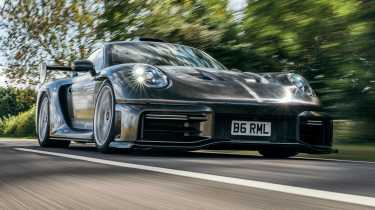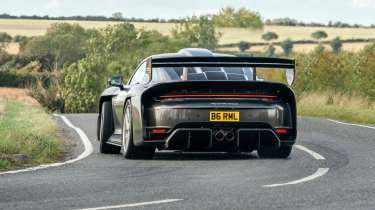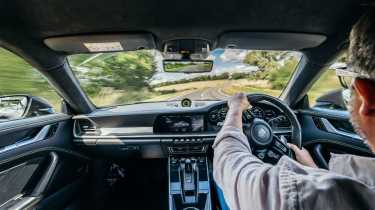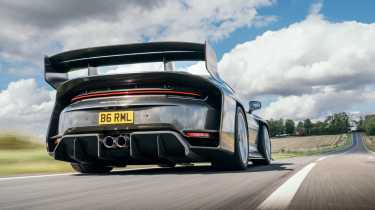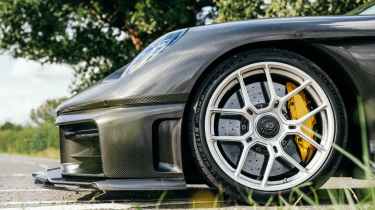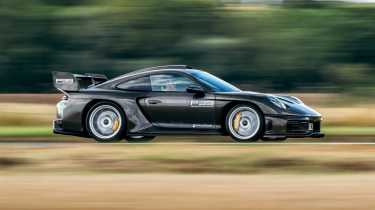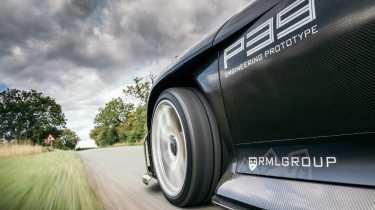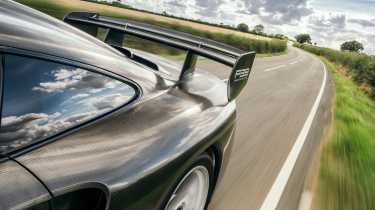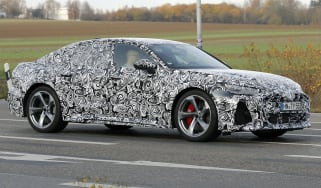RML GT Hypercar review – the Porsche 911 taken to the ultimate extreme
As close as anything’s gotten to being a modern day 911 GT1, the RML GT hypercar is a 900bhp monster
Porsche’s recently retired 992.1 911 Turbo S is one of the fastest point-to-point road cars ever built. Ruthlessly quick with a steely, cold-blooded character, the delivery is all about immense torque and fierce propulsive force, with a dynamic emphasis on traction, stability and effortlessly deployable speed.
But where most (including us) see a complete, highly evolved, daily-driveable supercar, Northamptonshire-based RML Bespoke saw raw potential. To prove the point, it set about augmenting a Turbo S with a suite of changes encompassing styling, aerodynamics, chassis and powertrain. The result – referred to internally as ‘P39’ but now officially named RML GT Hypercar – is a bewinged monster promising road and track performance to outstrip anything available from Porsche itself.
The most obvious aspect of this transformation is the wild-looking full-carbon bodywork. Drawing direct inspiration from the 911 GT1, it features an active aero package including a DRS function and develops up to 1000kg of downforce in its most aggressive setting. But the changes are more than skin-deep.
Extensive modifications have also been made to the chassis, with new suspension arms, hydraulically adjustable ride height and all-new adaptive dampers to achieve the wide-track stance (the track is increased by 100mm) and cope with the prodigious aero loadings. And then there’s the powertrain, which has been boosted from the standard car’s 641bhp to an altogether more serious 907bhp.
As you might imagine, such a transformation doesn’t come cheap. RML Bespoke charges customers a starting price of £520,000 plus taxes to turn their 992.1 Turbo S into a GT Hypercar. This is in addition to the value of the base car, which looking through UK online classifieds is currently somewhere between £175,000 and £200,000 for a low-mileage example in the right spec.
More reviews
With a limited run of 39 examples – the first ten of which will be 40th Editions to celebrate RML Group’s 40th landmark anniversary – the GT Hypercar will be a true rarity. One aimed at serious collectors who doubtless have a stable of supercars, crave truly hardcore performance and want something quite unlike anything else they already own.
Though the GT Hypercar is not a restomod in the accepted sense (there’s no ‘resto’ but a great deal of ‘mod’) RML Bespoke works to the same playbook, with each GTH built on a base car supplied by the customer and already registered in the country it will be returning to once completed.
Each build begins with the car being sent to Litchfield Motors for the engine work to be carried out. According to proprietor Iain Litchfield, although the specifics of the Turbo S are different, solving the challenge of extracting more power from a turbocharged engine is the same whether it’s a 911, Nissan GT-R or any of the other cars that Litchfield is renowned for tuning.
Getting more air in, developing more boost with no additional lag, and then managing the intake and exhaust temperatures are the main pillars of Litchfield’s upgrades, with precise tuning of the engine control software to ensure everything runs smoothly. The results are gobsmacking. As mentioned, power is up by 266bhp, while torque rises by 147lb ft above standard Turbo S levels to 737lb ft.
Iain Litchfield knows the 992 Turbo engine well and is full of praise for its engineering, which he describes as ‘ridiculously strong’. The PDK gearbox needs no uprated parts, with only tweaks made to the software to increase pressures within the hydraulic system to clamp the clutches a little harder.
Litchfield’s tuning cohorts who build and run production street cars for drag racing have proved there’s still another 20-30 per cent headroom in the engine and gearbox before internals need to be beefed-up. Clearly, the GT Hypercar is well within itself despite the monster gains.
Once back at RML, the 992 is stripped of its outer body panels until only the monocoque remains. The bodywork is then replaced with carbonfibre panels, including an enormous one-piece section that starts at the A-pillars and runs all the way back to the tail, forming the roof, roof scoop and huge rear haunches. Bonded to the underlying structure in a four-person process, this 19kg clamshell is a defining feature of the design.
To fill the wider body and increase the Turbo S’s footprint, RML replaces the standard suspension arms with all-new billet-machined items. It also uses this opportunity to extend the wheelbase by 25mm to improve high-speed stability and help the wheels sit more happily within the GTH’s elongated (by 170mm) proportions. Care has been taken to retain stock roll centres so that Porsche’s active anti-roll bars and rear-axle steering can still be used.
Adaptive dampers are supplied by R53 Suspension to RML’s specific requirements. Helper springs allow the GTH to run with a more pliant main spring, greater support being provided by the helper through big compressions or once increasing downforce begins to squeeze the car into the road.
There are three damper settings to choose from, selectable via one of a quartet of steering wheel-mounted rotary switches that closely resemble those found in a GT3 RS but are actually made in-house by RML. In addition to the damper settings, these rotaries control powertrain modes along with ride height and active aero/DRS, both served via the GT Hypercar’s new hydraulic system.
Switchable ride height is not something you’ll find on a factory 911. Offering a 55mm range of adjustment between ground-hugging Track mode (which is 15mm lower than the regular road ride height) and fully lifted to clear speed humps (up by 40mm compared with the regular ride height), the adjustments are made in a split second.
The rest of the GTH’s interior is regulation 992. In this development car that means no embellishment, but in customer cars there will be much greater scope for personalisation of colour and trim. Being so clearly rooted to the production model might be a disappointment, especially when the exterior deviates so far from the original, but given its soundness it’s perhaps forgivable not to attempt to reinvent the standard cockpit.
The GTH is an intriguing car to get to know. It presents like a GT3 RS crossed with an old-school GT1, and it feels like it, too. Big, boosty Porsches always possess a certain swagger, be they road-going 911s or the wildest 917‑30. The GTH shares that sense of simmering ferocity, the feeling of it rapidly filling its lungs and the burgeoning swell of torque providing an instant hit of adrenaline.
It’s a very different experience to the Manthey-kitted 992 RS – the GTH’s most obvious rival – which is needle-sharp in its responses, but with a thin delivery that relies on being above 6000rpm to give its best. You can dawdle in the RS, but the GTH allows you to flex immeasurably more muscle with less effort, a gentle squeeze of the throttle in a high gear sufficient to surge you by slower traffic with imperious ease.
When it comes to steering response, the GTH is much keener than a Turbo S but with less immediacy and connection than an RS. It’s consistent with the processed and heavily filtered feel you get from the all-wheel-drive Turbo S, but with more rotational energy and far greater reserves of grip.
What you don’t get is that incredible on-the-nose feeling that the RS, and Manthey RS in particular, have been honed to deliver. In truth the GTH probably wouldn’t work so well with that extreme level of keenness because, unlike the RS, you’re working the chassis harder with all that torque, so you need to have a little lateral and longitudinal grip in reserve.
Through tighter, low-speed corners you don’t get the benefit of the aero, so the GTH is more conventional in its behaviour, with a neutral balance that you can adjust with your throttle inputs. Smoothly release the brakes as you turn in, progressively load the outside front and then squeeze into the throttle and you’ll eventually feel the nose begin to push.
Load the nose more under the brakes, then release them more sharply as you make your initial turn, and the GTH rotates with more energy, which then allows you to exploit the shift in balance with earlier throttle inputs. It’s standard 911 stuff, but fun to discover it still works in the GTH.
It’s not possible – or permitted – to dig into the safety-critical areas of a car’s control systems, so the Turbo S PSM system remains standard. The result is a stability control system that is generally fine but has occasional lapses in consistency. Greedy throttle inputs early in a corner bring immediate and intrusive intervention from PSM, but more measured throttle applications avoid the sharp spike in torque, so PSM isn’t triggered.
Continue with that smooth, insistent increase in throttle opening and the escalating swell of torque can catch the PSM napping, to the point where you can have the GTH oversteering under power without the electronics doing much to rein things in.
It’s worth pointing out that this was experienced while shooting cornering shots rather than normal driving (ahem), but the fact that we got the images used here without disabling the PSM is illustrative of how much slip can occur without intervention.
It’s not a serious issue, but if your expectations have been set by the fidelity of a 992 RS’s stability control, or indeed that found in a contemporary Ferrari or McLaren supercar, then allowances need to be made for those rare moments where the GT Hypercar overreaches certain parameters of its standard software.
The brakes – stock Turbo S items – present no such issues. The huge PCCB discs are 420mm at the front and 390 at the rear, gripped by ten-and four-piston monobloc calipers respectively. The pedal is firm and feelsome with plenty of confidence-inspiring response, and easily modulated for smooth progress. And with more than 1000kg of aero loading at 180mph, the GT Hypercar should be an absolute beast when making big stops on track.
Do you feel the downforce on the road? At times, yes, but you need to extend the wings in Track mode and drive at speeds best not committed to print to really feel them working. Fast sweeps are especially satisfying, with an on-rails feeling that’s hugely impressive. It takes a leap of faith to guide the GTH into such corners unchecked by a confidence dab on the brakes, but the way it peels into quick curves is intoxicating.
You soon begin to see familiar stretches of road through different eyes as the cornering capabilities change your normal frames of reference. Such parameter-shifting cornering performance takes away a certain degree of driver input, but exercising your judgement (not to mention self-control) quickly occupies that vacated area of mental bandwidth.
Above all it’s very special to have this combination of supercar stick and eye-widening stonk in a civilised and perfectly streetable 911. The Litchfield-tuned engine is a force of nature. The soundtrack pumped from the tailpipes of the GTH’s full Inconel exhaust system is gruff and grouchy at start-up, with a deliciously deep and urgent idle.
It sets a serious tone but is nothing compared to the range of respiratory noises this heavily turbocharged flat-six makes as you squeeze in and out of the throttle. Imagine Darth Vader with a nasty case of bronchitis and you won’t be far off the mark. From the outside it’s like spectating at Le Mans in the 1990s.
Considering it’s putting out 740bhp in its default mode and 907bhp in Track (dropping to a piffling 650bhp in Wet) its manners are impeccable, with smooth, tractable part-throttle response. Selecting a high gear at very low speed and then flooring the throttle is a particularly entertaining party piece, as you really get that sensation of being pulled towards the horizon with increasing intensity, as if by an invisible bungee. That’s what 737lb ft in 1540kg (100kg less than a stock Turbo S) does for you.
Much like the juxtaposition of Dark Knight bodywork and Bruce Wayne interior, it’s this contrast between driving the GT Hypercar in higher gears at lower revs with small throttle openings, and in lower gears with wide-open throttle and full-boost, that’s part of its unique appeal. Few cars do mild and wild quite so effectively.
As a result, the GT Hypercar is an impossible car to pigeonhole. There’s no shortage of transformed air-cooled Porsche 911s with big-ticket prices around these days, but being based on a contemporary model is certainly to the GTH’s advantage. What’s less clear-cut is whether its admirable and obvious focus on performance is enough to captivate those who are accustomed to Singer levels of aesthetic beauty and ultra-luxury interior detailing.
Given the gulf in price between Singer’s DLS Turbo (£1.5m-plus) and the GTH, such comparisons are perhaps unfair, but also inevitable given RML Bespoke’s choice of base car. In truth, though very different, there are clearer parallels between the GT Hypercar and Prodrive’s Impreza P25. Each comes from a company steeped in motorsport success, with in-house skillsets bolstered by diversification into white-label engineering and development programmes for OE manufacturers.
Motorsport might now only represent ten per cent of RML Group’s business, but I’d venture to say it still informs 90 per cent of the company’s DNA. This much is clear from the GTH project’s objectives and impressively compressed development timeframe: just 18 months from initial ideation in late-winter ’24 to unveiling the first customer car at the end of August.
The GTH is an authentic reflection of RML Bespoke’s ambition and hardwired instinct for empirical gains. What it does and how it does it is incredibly exciting, unlike anything else out there. Driving it on the road is an absolute blast, but you can only scratch at its outright capabilities. Oh, to take it on a road trip to Spa or the Ring and experience the full scope of its performance. Next year, perhaps…
Specs
| Engine | Flat-six, 3745cc, twin-turbo |
|---|---|
| Power | Power 907bhp @ 7300rpm |
| Torque | Torque 737lb ft @ 4500rpm |
| Weight | Weight 1540kg (598bhp/ton) |
| Tyres as tested | Michelin Pilot Sport Cup 2 |
| 0-62mph | 2.4sec |
| Top speed | 205mph |
| Price | c/£750k (including donor and taxes) |
